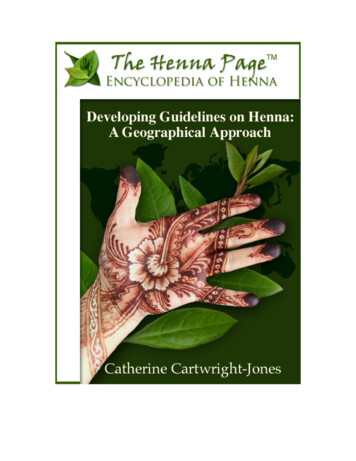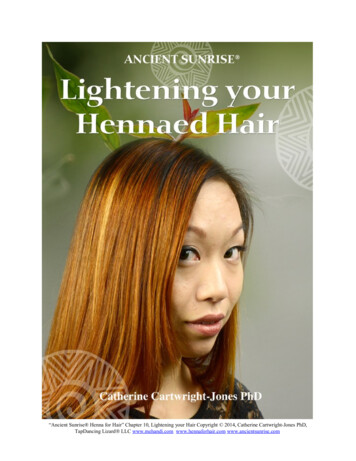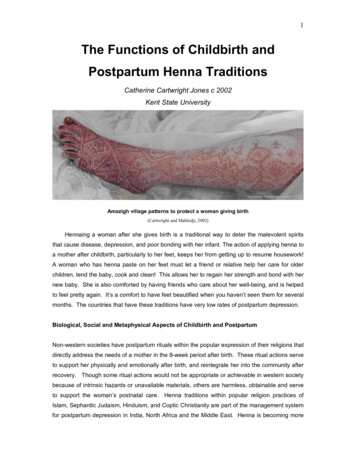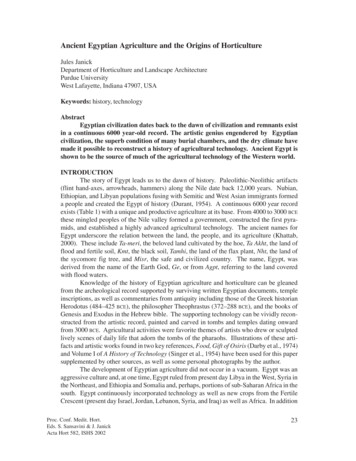
Transcription
2DEVELOPING GUIDELINES ON HENNA:A GEOGRAPHICAL APPROACHByCatherine Cartwright-JonesAugust 2006An essay submitted toKent State Universityin partial fulfillment of the requirementsfor the Master of Liberal Studies degreeCopyright 2006 Catherine Cartwright-JonesPublished by Henna Page Publications, a division of TapDancing Lizard LLC4237 Klein Ave. Stow, Ohio 44224 USA All rights reserved.
3TABLE OF CONTENTS:PREFACEChapter I:Introduction: The Emergence of Henna into the West and the Need for aSystematic Study of HennaThe Problems Created by Henna’s Rapidly Changing GeographiesPerspectiveThe Lack of a Systematic Study of HennaIdentifying Henna and Proposing Criteria for a Systematic Study of HennaChapter II:Criteria for a Systematic Investigation of HennaThe Henna Plant; Lawsonia InermisHenna’s Growing Range: Global RegionsCopyright 2006 Catherine Cartwright-JonesPublished by Henna Page Publications, a division of TapDancing Lizard LLC4237 Klein Ave. Stow, Ohio 44224 USA All rights reserved.
4Henna’s Growing Range: Temperature Minima and HennaHenna’s Growing Range: Precipitation and HennaHenna’s Present Growth RangeThe Color of HennaThe Basis of Henna Color: LawsoneThe Geography of Skin and Henna: Henna Stains on SkinDifferentiating Henna From Other Forms of Body Art: TattoosDifferentiating Henna From Other Forms of Body Art: PaintsDifferentiating Henna From Other Forms of Body Art: ScarificationDifferentiating Henna From Other Indian Body Adornments That ResembleHenna: Impatiens BalsamicaDifferentiating henna From Other Indian Body Adornments that ResembleHenna: LacCultural Carriers of HennaChapter III:Using Criteria to Evaluate Body Markings on ArtifactsCriteria Groups for Evaluating Artifacts with Body MarkingsCriteria Group One: Negative Evidence of HennaCriteria Group Two: Positive Evidence of HennaCopyright 2006 Catherine Cartwright-JonesPublished by Henna Page Publications, a division of TapDancing Lizard LLC4237 Klein Ave. Stow, Ohio 44224 USA All rights reserved.
5Criteria Group Three: Supporting evidence of HennaCriteria Group Four: Ambivalent Evidence of HennaUsing the Criteria Groups to Evaluate Evidence of Henna Body ArtExample OneExample TwoExample ThreeExample FourExample FiveExample SixExample SevenExample EightExample NineExample TenThe Results of the EvaluationsChapter IV:Mapping the Historical Regions of HennaLocation of Artifacts Between 6000 BCE and 3000 BCE That Have PositiveEvidence of Henna UseCopyright 2006 Catherine Cartwright-JonesPublished by Henna Page Publications, a division of TapDancing Lizard LLC4237 Klein Ave. Stow, Ohio 44224 USA All rights reserved.
6Location of Artifacts Between 3000 BCE and 1400 BCE That Have PositiveEvidence of Henna UseLocation of Artifacts Between 1400 BCE and 500 BCE That Have PositiveEvidence of Henna UseLocation of Artifacts Between 500 BCE and 700CE That Have Positive Evidenceof Henna UseLocation of Artifacts between 700 BCE and 1250 BCE That Have PositiveEvidence of Henna UseLocation of Artifacts Between 1250 BCE and 1700 BCE That Have PositiveEvidence of Henna UseAreas of Henna Body Art Practices in the Early Twentieth CenturyAreas of Henna Body Art Practices in the Early Twenty-first Century: Tradition,Immigration, Westernization and Para-PhenylenediamineThe Geographies of Henna Emergence in the WestThe Geographies of Para-phenylenediamine “Black Henna” as Body ArtThe Geographies of Traditional Henna Use in the Early 21st CenturyChapter V:Conclusion: The Potential of a Geographical Approach to HennaCopyright 2006 Catherine Cartwright-JonesPublished by Henna Page Publications, a division of TapDancing Lizard LLC4237 Klein Ave. Stow, Ohio 44224 USA All rights reserved.
7Appendix:Larger versions of maps included in Developing Guidelines to Henna: AGeographic ApproachReferencesMaps and Mapping Data referencesKnowledgeable sourcesAdditional photographs and drawings provided by authorCopyright 2006 Catherine Cartwright-JonesPublished by Henna Page Publications, a division of TapDancing Lizard LLC4237 Klein Ave. Stow, Ohio 44224 USA All rights reserved.
8DEVELOPING GUIDELINES ON HENNA:A GEOGRAPHICAL APPROACHChapter I:Introduction: The Emergence of Henna into the West and the Need for a SystematicStudy of HennaCopyright 2006 Catherine Cartwright-JonesPublished by Henna Page Publications, a division of TapDancing Lizard LLC4237 Klein Ave. Stow, Ohio 44224 USA All rights reserved.
9Figure 1: Henna body art: stain on skin (Cartwright-Jones, 2005)“ I didn’t know white people did henna!” (Indian-American girl observing CatherineCartwright-Jones apply bridal henna to her older sister: Mansfield, Ohio, 2005)During the last twenty years, henna body art has emerged from South Asia, the Levant,the Arabian Peninsula and North Africa into the popular culture of the USA, Canada,Europe and the UK (Maira, 2000). The western world has little understanding of henna,its techniques, traditions or history, and no legal or commercial framework for definitionor regulation of henna. There have been scattered mentions of henna in anthropological,botanical, medical, historical, economic and legal literatures, but there has never been anintegrated multidisciplinary study of what henna is. There is no resource on henna thatincludes where it was used, when it was used, how it was used, why it was used, whoused it, nor have these elements been linked. The lack of a coordinated source ofinformation about henna hampers not only academic for discussion about henna’s historyCopyright 2006 Catherine Cartwright-JonesPublished by Henna Page Publications, a division of TapDancing Lizard LLC4237 Klein Ave. Stow, Ohio 44224 USA All rights reserved.
10and traditions, but stands in the way of ordinary people’s understanding and enjoyment ofhenna.In this first chapter, I will demonstrate the need for a scholarly investigation of henna,particularly the historic regions of henna body art. Chapter two will define the criteria forinvestigating henna. Chapter three will test the usefulness of the proposed criteria.Chapter four will show how historical regions of henna can be mapped based on theseinvestigations. Chapter five will propose the potential use of mapping the geographies ofhenna.Problems Created by Henna’s Rapidly Changing GeographiesHenna body art surged into the west following the 1998 release of Madonna’s musicvideo “Frozen”, when the “Om” patterns on her hands were viewed by millions of peoplewho had never seen henna before. Henna kits and henna tattoos were suddenly the hottestimpulse purchase everywhere (Maira, 2000). However, indigenous understanding oftechniques, traditions and context did not accompany the shipments of henna powder andpaste. The only written references on henna application and traditions were a few popularpress publications, quickly published to ride the pop culture profit wave. These eitherpromoted fashionable henna artists (Roome 1998, Batra & Wilde, 1999), or were meantCopyright 2006 Catherine Cartwright-JonesPublished by Henna Page Publications, a division of TapDancing Lizard LLC4237 Klein Ave. Stow, Ohio 44224 USA All rights reserved.
11to sell henna products (Marron 1998, Fabius 1998). Though these gave westerners a“beginners guide” to henna, they did not provide substantive information about thescience, art, history and traditions of henna.An artist must have high quality henna, skill and experience to make get good resultsfrom their work. Patrons must understand that they have to keep the henna paste on theskin for several hours, and allow the resulting stain to darken for the following two days.When artists and patrons became impatient with traditional henna techniques, and wereunable to find training, they often abandoned henna, substitute a fast-acting, cheap,widely available chemical hair dye: black para-phenylenediamine. This was sold as“black henna.” Para-phenylenediamine paste makes a fashionably black stain on skinwithin an hour, similar in appearance to a needle tattoo. Para-phenylenediamine “blackhenna” causes severe injuries as seen in Figure 3, and has become a major health concernaround the world (Sosted, Johansen, Andersen, & Menné, 2006).Copyright 2006 Catherine Cartwright-JonesPublished by Henna Page Publications, a division of TapDancing Lizard LLC4237 Klein Ave. Stow, Ohio 44224 USA All rights reserved.
12Figure 2: Street side artists attract clients with signs of “henna tattoos”(Cartwright-Jones collection, Greece, 2003)Figure 2 shows a typical western “henna” sidewalk artisan, working a summer beachfrontlocation on a Greek island, not very different from sidewalk henna artists around theworld. This artisan advertises “black henna”. There is no such plant as “black henna.”These “black henna” tattoos are popular in vacation resorts around the world, and touristsare unaware that this is not henna, and are often injured by the para-phenylnediaminepastes (Van den Keybus, Morren, & Goossens, 2005). The USA placed a ban on importsof henna for body art following the rise in popularity of “black henna”, and confusionover the cause of the injuries.In Los Angeles, one of the first areas of henna emergence in the USA, sidewalk hennaartists set up on the Third Street Promenade in Santa Monica in the late 1990’s, similar tothose in figure 2. Because neither artists nor patrons were familiar with henna, sidewalkCopyright 2006 Catherine Cartwright-JonesPublished by Henna Page Publications, a division of TapDancing Lizard LLC4237 Klein Ave. Stow, Ohio 44224 USA All rights reserved.
13artists substituted para-phenylenediamine for henna, marketing it as “black henna”.Inevitably, a purchaser developed injuries similar to Figure 3, and sued the city of SantaMonica. The city subsequently banned henna body art. The city may have been unawarethat para-phenylenediamine, not henna, was the causative factor in injury, or it may havebeen unwilling to police artists’ mixes for the chemical (White & White, 2001). Thissequence has been repeated in many countries.Figure 3: Blistering and scarring from para-phenylenediamine applied to skin, sold as a“black henna tattoo” in Rome, Italy (Willett, 2005)An example of the problems created by this lack of information about henna in the westis a discussion at alt.religion.Christian.biblestudy, June 30, 2005, thread 18, an online usegroup (Willit, 2005b).Willitt writes, “I have challenged gods, all of them, to showthemselves. Many times. No result. Two weeks before the latest effort my daughter on aschool trip to Rome has a "henna tattoo" done which she reacts to a week later, as manypeople have done before. This you take to be a Holy Sign from God. So your god givesmy daughter a sign that she may bear for the rest of her life as a lesson to me? Mysteriousways? Tell me about it!”Willit shows his daughter’s injury, Figure 2, in his weblog(2005a), and writes further about it, “The reason for the heart-to-heart was to tell herCopyright 2006 Catherine Cartwright-JonesPublished by Henna Page Publications, a division of TapDancing Lizard LLC4237 Klein Ave. Stow, Ohio 44224 USA All rights reserved.
14that a Christian has put down her problems with the henna tattoo to the wrath of his everloving and merciful God.”The misconceptions about henna in this statement are not unusual, and evidence theproblems of henna’s emergence into a geographic area where there is no traditionalknowledge of henna. The problems in this are:1. The skin reaction referred to by Willitt is not from henna, which is virtuallyharmless, but to para-phenylenediamine black hair dye (Stante, Giorgini, & Lotti,2006.)2. The street artist in Rome incorrectly termed para-phenylenediamine as “blackhenna.” This is often done to create a fast black skin stain by people who do notknow how to safely mix and apply henna.3. The British purchaser did not know that there is no such plant as “black henna”,and did not know that henna never leaves a black stain on the upper arm.4. Local regulations did not distinguish between safe application of henna anddangerous application of para-phenylenediamine paste.5. The Western writer construes that the blistering and scarring may be an exampleof the Christian God’s judgment against henna, a practice indigenous to“Oriental” cultures.If the street side artist, the purchaser, and the local regulators understood what henna is,what it is not, how it is applied, and what the history and traditions of henna are, Willit’sCopyright 2006 Catherine Cartwright-JonesPublished by Henna Page Publications, a division of TapDancing Lizard LLC4237 Klein Ave. Stow, Ohio 44224 USA All rights reserved.
15daughter would not have been injured. The understanding of henna is implicit in thecultures where it has been used safely as body art for thousands of years.Theunderstanding of henna in the cultures where it has recently emerged is poor, andpractices are unsafe!In the USA, there is a fundamental contradiction in the legal status of henna based onlack of information about the history, traditions and use of henna. The USA presentlyallows henna to be unconditionally imported as hair dye: FDA Code of Regulations, Title21, Volume 1, Chapter 1, Part 73, Sec. 73.2190: Henna, but forbids the use of henna forbody art (FDA, 1997). Customs is charged to confiscate all henna entering the USA thathas any evidence that it will be used for body art, “In April, 1997, LOS-DO examinedtwo shipments of a hair color product, brand names Zarqa and Almas, or color additives.Neither product has directions for use. However, the labels for both products declarehenna as the sole ingredient and depict designs on the hands and feet. The color additiveregulation 21 CFR 73.2190 specifically allows for the safe use of henna in coloring thehair only. The regulation does not allow for the safe use of henna to make coloreddesigns directly on the skin, including the hands and feet.”Most of the femalepopulation of South Asia, the Levant, North Africa and the Arabian Peninsula adorn theirhands and feet with henna at least once in their lives, usually at a wedding, and may use itregularly for celebrating social and religious holidays. Adverse reactions in adults areextremely rare. Dermatologists regard henna as virtually harmless for use in staining skin,(Jung et al, 2006), and henna has been used as body art for thousands of years. The FDAruling was put in place before there was any awareness that henna was used as a body artCopyright 2006 Catherine Cartwright-JonesPublished by Henna Page Publications, a division of TapDancing Lizard LLC4237 Klein Ave. Stow, Ohio 44224 USA All rights reserved.
16in other countries, and before there was a significant immigrant population in the USAthat would want to retain henna as part of their traditional culture.A thorough investigation of henna, enabled by defining of what henna is and is not, iscrucial to legal, marketing, health, safety, ethnic and religious issues surrounding henna’spresent introduction into western culture. Up to this point, there has been no organizedstudy of henna, not even a set of criterion for undertaking that study. This paper proposesto identify the components that would make it possible to construct the history of henna,its traditions, its art and science: a geographic approach to henna.Perspective:I have been in a unique position to view the emergence of henna into the west, and theproblems and potential created by this emergence.I have been a henna artist andresearcher since 1990. Most of the body art photographs in “Developing Guidelines onHenna: a Geographical Approach” are my own henna work. I have had the opportunityresearch henna history in the archives of the Bodliean and British Libraries, funded by agrant from the Iranian Heritage Foundation. From these experiences as an artist andresearcher, I am very familiar with henna and its interaction with skin. I currently ownand operate hennapage.com, the henna website consistently ranked top on search enginesCopyright 2006 Catherine Cartwright-JonesPublished by Henna Page Publications, a division of TapDancing Lizard LLC4237 Klein Ave. Stow, Ohio 44224 USA All rights reserved.
17since its inception in 1996. During June 2006, The Henna Page had over seven thousandvisitors per day, according web stat report from the Visox.net. I also own and operate abusiness importing and exporting henna, and am familiar with the logistical problems ofmoving henna across through the legal, cultural, and financial networks. I organize andlecture at the International Henna Conferences, where I am able to meet and work withhenna artists from around the English-speaking world. Through these contacts, businessrecords and my academic research, I have been able to observe the movement of henna,and gather information on the emerging and ancient geographies of henna.The Lack of a Systematic Study of HennaThe western academic community has paid scant attention to henna. As a women’stradition, it was not easily available to male anthropologists and explorers, nor was bodyart studied seriously as a cultural expression until recently. Henna and HipHop (Maira,2000) has a thorough and insightful analysis of henna’s explosion into the western popfashion industry in the late 1990’s, but does not attempt to set this into an understandingof the plant, the traditions, nor the history of henna. Field (1958) compiled a literaturereview of mentions of henna from a wide range of sources, including the Ebers Papyrus,Josephus, Pliny III, and Clement of Alexandria through colonial travelers such asSonnini, Lady Burton, and Tavernier. Rather than illuminating the history of henna, thisCopyright 2006 Catherine Cartwright-JonesPublished by Henna Page Publications, a division of TapDancing Lizard LLC4237 Klein Ave. Stow, Ohio 44224 USA All rights reserved.
18revealed that there had never been more than sporadic and disconnected mentions ofhenna by western observers.Westermarck (1914 and 1924) documents details of henna traditions in Morocco in theearly 20th century, but do not elaborate on the specific materials, techniques, or the artists.Sijelmassi (1974) draws some of the patterns used for henna in his larger work onMoroccan art. Messina (1988) writes about women’s henna parties in Morocco, withmore detail than her predecessors about the patterns, events, and social purposes. Tauzinwrites in great detail about contemporary henna art in Mauritania, and makes a smallattempt to assemble some historical references, but falls back on the same phrase spokenin different ways throughout the literature, “L’utilisation du henné est très ancienne, enmême temps que le sens à lui donner demeure souvent obscur” (Tauzin, 1988:11). Allauthors make it clear that henna is longstanding and an integral part of the culture, butthey offer neither specifics of its origins nor its connections with henna use in othercultures.A few indigenous authors have written about henna, though it is unusual for mostly malewriters to take much notice of what is essentially a women’s art. Saksena (1979) detailsRajasthani henna patterns and traditions, but fails to interview or quote any Rajasthaniwomen when discussing henna. He offers his own opinions on henna, such as “Mehndiacts like a charm and would keep your begums confined to their harems if their handswere decorated with mehndi once a week. Then they would need no guards and nochains to hold them (p. 96).” He offers some unfortunate advice on mixing henna, suchCopyright 2006 Catherine Cartwright-JonesPublished by Henna Page Publications, a division of TapDancing Lizard LLC4237 Klein Ave. Stow, Ohio 44224 USA All rights reserved.
19adding of kerosene to the henna paste (p. 59). He makes some unusual claims for henna,“if the paste were tied round the joints of a horse’s legs, he would go four to five hundredmiles without feeling any fatigue” and “a bandage of wet mehndi cures the severest ofheadaches (p. 96).” Saksena also states that there is no Muslim tradition of patternedhenna, and that henna looks dirty and messy on dark skinned people, contradictingabundant evidence of complex henna art in Moorish Spain, Iraq, and Iran in the 12ththrough 17th centuries, and African henna traditions. Saksena is under the impressionthat henna originated in India and traveled west from there, a premise widely contradictedby archaeological evidence. “The Victim and Its Masks” (Hammoudi, 1993) mentionsthe use of henna for Id sacrifice by the Ait Mizane of southern Morocco but does notconnect sacrificial henna to range of other henna practices, nor does he attempt toilluminate the history of the practice.Old medical texts have useful references for placing henna in historical geographies: TheEbers Papyrus, written around 1550 BCE in Egypt details the medicinal attributes ofhenna grown in soils of differing moisture content, and characteristics of different partsof the plant (Bryan, 1974). Medicine of the Prophet (Al Jawziyya, tr. Johnstone 1998)lists specific uses for henna, including treatment of migraines. However, medical textsdo not concern themselves with henna as body art.Descriptions of cosmetics and cosmetic formularies are a useful source of historicalplacement for henna.Ovid’s verses about women’s cosmetic habits imply Romanwomen dyed their hair with henna (Schmidt, 1924: 26). Early editions of Chemist andCopyright 2006 Catherine Cartwright-JonesPublished by Henna Page Publications, a division of TapDancing Lizard LLC4237 Klein Ave. Stow, Ohio 44224 USA All rights reserved.
20Druggist provide articles on henna as hair dye, as well as historical mentions, such as thatthe Dialogues of Lucian mention that Greek women tinted their hair and nails with henna(Chemist and Druggist, 1932). Chemist and Druggist (1926) also sheds light on theconfusion surrounding the introduction of henna into the west: the wide varieties ofhenna hair dye with undeclared ingredients. “Neutral henna”, “red henna” and “blackhenna” were widely sold for blonde, red, and black hair. Only red henna was actuallylawsonia inermis. Neutral henna was cassia obovata, and black henna was indigoferatinctoria. The dried powdered leaves of all of these plants appear very similar. Exportersof these hair dyes were reluctant to give away their trade secrets, and declarations ofingredients were not required during the early twentieth century. Additional confusionabout henna comes from the addition of lead, copper, and iron sulphates and acetates,used to create other tones of hair dye. These are also usually undeclared ingredients in apackage simply labeled “Henna” (Chemist and Druggist, 1925). This confusion aboutwhat henna is and is not opened the way for the current problems with paraphenylenediamine black dyes substituted for henna, and the subsequent problems withconfiscation and banning of henna as body art.Henna is mentioned in the King James Version of the Bible (Holy Bible, KJV), the OldTestament, by its Latin name, camphire: “I am my beloved's, and his desire is for me.Come, my beloved, Let us go into the open, Let us lodge among the camphire” (Song ofSongs 7:11-13), "Your shoots are a royal garden full of pomegranates, with choice fruits:camphire and spikenard" (Song of Solomon, IV, 13), and "My Beloved is unto me as acluster of camphire in the vineyards of En-Gedi" (Song of Solomon, I, 14). There areCopyright 2006 Catherine Cartwright-JonesPublished by Henna Page Publications, a division of TapDancing Lizard LLC4237 Klein Ave. Stow, Ohio 44224 USA All rights reserved.
21well-documented henna traditions among Armenian Christians, Coptic Christians, andamong all of the Jewish groups that lived North Africa, the Arabian Peninsula and theLevant.Yet, some priests such as Father Peter Joseph (2002) condemn henna asunsuitable for Christians. Rabbi Jack (2005), of New York City, posting on the NationalConference of Synagogue Youth, advises, “Henna tattoos are Rabbinically prohibitedeven when two youths asked him pointedly about the Yemenite and Sephardic Jewishhenna traditions.A potential source of information on henna, people who have emigrated from countrieswhere henna is an indigenous tradition, is not as accessible as one would hope. When Ibegan researching henna in 1990, I went to Arab markets in the Akron and Cleveland,Ohio areas, and asked to purchase henna, and how to use it. The answer was usually,“Why do you want that old-fashioned filthy stuff?” This attitude is demonstrated in anarticle about Egyptian night of the henna in the countryside, “the henna stain remains forweeks; it is thus city couples that find its appearance inappropriate to office or schoolsettings, who tend to abandon this tradition” (Morgan, 1995).In an Iraqi Arabicdictionary, this bias against henna is shown in an example following the definition ofhenna, “Educated girls don’t put henna on before their marriage.” (Clarity, Stowasser,Wolfe, Woodhead, & Beene, 2003: 122)The scarcity of reliable information on henna in western publications adversely impactslegal, economic, health, cultural, and religious issues tangent to henna. A fundamentalacademic investigation of henna, enabled by defining what henna is and is not, is sorelyneeded to integrate it into the body of knowledge, and to facilitate henna’s introductionCopyright 2006 Catherine Cartwright-JonesPublished by Henna Page Publications, a division of TapDancing Lizard LLC4237 Klein Ave. Stow, Ohio 44224 USA All rights reserved.
22into western culture. Up to this point, there has been no organized study of henna, noteven a set of criteria for undertaking that study. This paper proposes to identify thecriteria that would make the historical, anthropological, economic and legal study ofhenna possible.Identifying Henna and Proposing Criteria for a Systematic Study of HennaTo construct a systematic study of henna, it must be identified and understood as a plant,as a material culture including its cosmetic, medicinal, and ritual traditions, and allaspects must be situated in geographies and history. To this end, henna and its uses mustbe precisely identified.Figure 4: Henna body art, paste on skin (Cartwright-Jones, 2005)Copyright 2006 Catherine Cartwright-JonesPublished by Henna Page Publications, a division of TapDancing Lizard LLC4237 Klein Ave. Stow, Ohio 44224 USA All rights reserved.
23Henna body art is the practice of staining the skin with a paste made of henna, lawsoniainermis, leaves that have been pulverized and mixed with a slightly acidic liquid. Thesestains last longer than pigmented cosmetics, but are not permanent as are tattooing,scarification and piercing. Henna is also used to dye hair and fingernails, and has beenused medicinally in India, the Middle East and North Africa. Henna body art is presentlypopular as adornment for weddings and other celebrations in South Asia, the Middle Eastand Africa, and there is text and pictorial evidence that henna has been used foradornment for over 5,000 years.When dried henna leaves are pulverized, wetted and applied to the skin for half an houror more, lawsone, the dye molecule in henna leaves, breaches cells, penetrates and stainskeratin in skin, hair, and nails just as the liquid from a teabag penetrates and stainscellulose in a white cotton tablecloth.Figure 1 shows the stain left from the pasteapplication in Figure 4.Henna body art is a transitory skin stain and can only be directly observed during the fewweeks that it is on a living body. Text and artifact evidence indicate that people mayhave used henna as an adornment since the late Neolithic, though use can only beindirectly observed, and thus far has been only sporadically studied. The lack of areliable history of henna underlies the misconceptions held by Willit and Rabbi Jack, andthe problematic FDA legislation.Copyright 2006 Catherine Cartwright-JonesPublished by Henna Page Publications, a division of TapDancing Lizard LLC4237 Klein Ave. Stow, Ohio 44224 USA All rights reserved.
24Constructing a history of henna is challenging. We can verify the presence of hennapatterns on living skin by observing this characteristic paste application, color afterremoval, fragrance, and subsequent disappearance of the pattern. We cannot directlyobserve henna that was applied a month ago, because the henna stains exfoliate within amonth. We cannot directly observe henna that was applied several thousand years ago,because the living people are gone. In the absence of direct observation, how can onestudy henna in the past, particularly in the distant past? Field (1958) provides an archiveof henna mentions in text. Barring difficulties with translations of the names of plants,one could assemble historic geographies of henna from text mentions, but this would onlyreach as far into the past as text exists. Also, text rarely evidences the patterns of hennain body art. How, then, can one establish the existence of henna use and thecharacteristics of application in the absence of text?Eastern Mediterranean statuettes and wall paintings from as early as 3500 BCE depictwomen with red stained hands (Getz-Preziosi, 1994: 49). Can we claim these artifacts asevidence of early henna traditions? How can one prove that a transitory body art existedwhen there can be no directly observable evidence? One can identify criteria based ondirect observations of henna and its interaction with skin that facilitate evaluation ofindirect evidence of henna body art within a specific time and location. For instance, inFigures 5 through 14, what evidence would be needed to interpret the body markings?Copyright 2006 Catherine Cartwright-JonesPublished by Henna Page Publications, a division of TapDancing Lizard LLC4237 Klein Ave. Stow, Ohio 44224 USA All rights reserved.
25Figure 5: Two Harem girls, attributed to Mirza Baba, Iran 1811-14, Collection of theRoyal Asiatic Society London, 01.002Figure 6: A Lady Playing the Tanpura, Rajasthan, Kishangarh, ca
Figure 2: Street side artists attract clients with signs of "henna tattoos" (Cartwright-Jones collection, Greece, 2003) Figure 2 shows a typical western "henna" sidewalk artisan, working a summer beachfront location on a Greek island, not very different from sidewalk henna artists around the world. This artisan advertises "black henna".










![INDEX [ breadforbeggars ]](/img/32/song-of-songs-advent-for-couples.jpg)